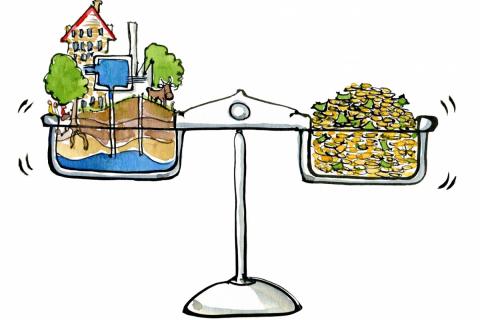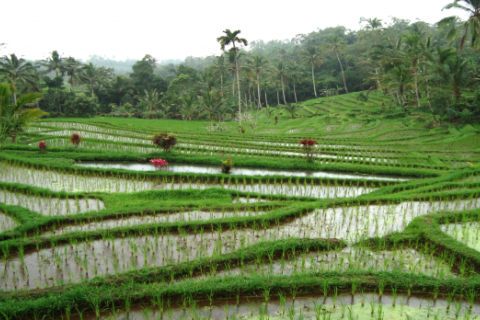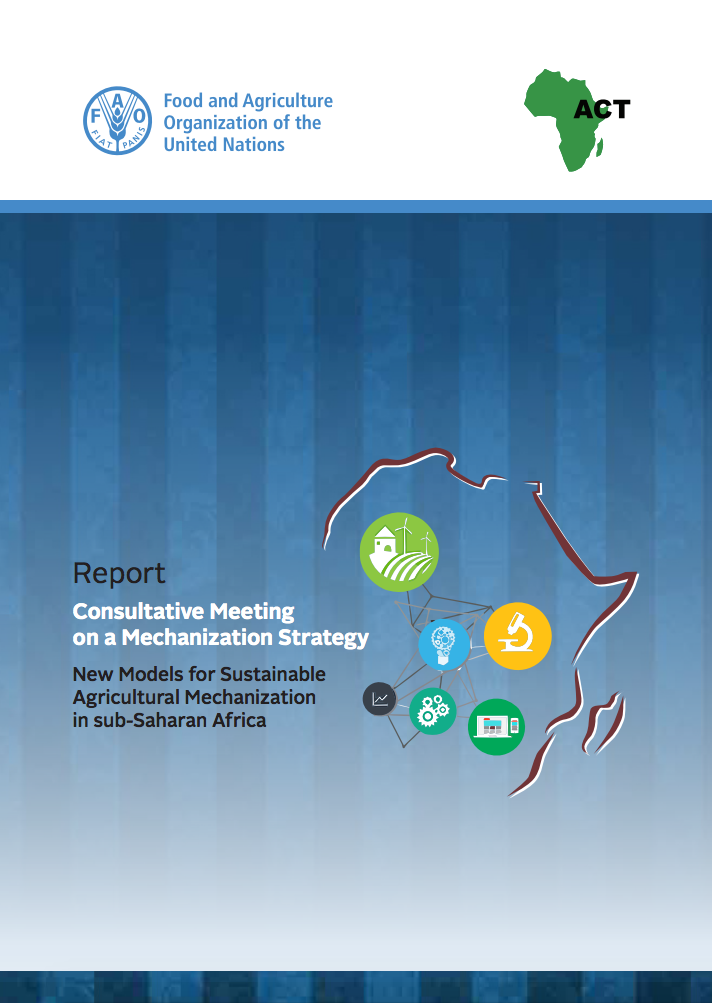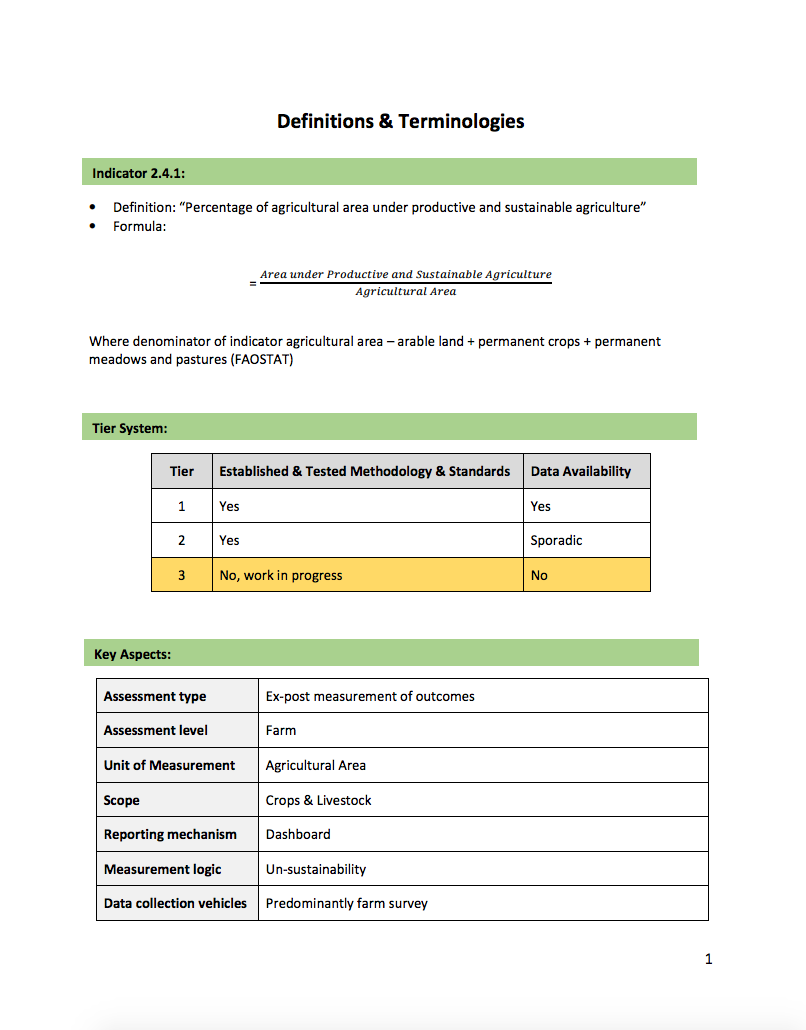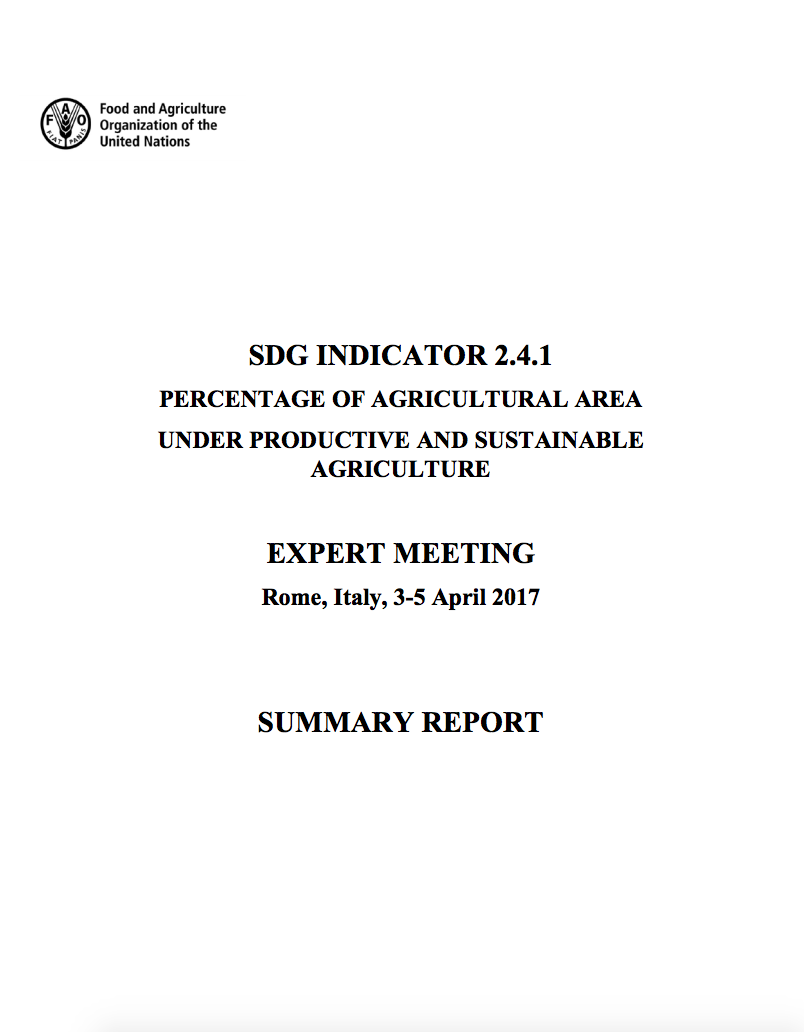
Proportion of agricultural area under productive and sustainable agriculture
Last updated on 1 February 2022
This indicator is currently classified as Tier II. The Food and Agriculture Organization of the United Nations (FAO) is the Custodian agency for this indicator.
Unit of measure: The indicator is unitless, expressing a ratio between area under sustainable and productive agriculture and total agricultural land area (%).
Why is this indicator important?
Harmful, unsustainable agricultural practices from extractive industries, large-scale agricultural producers, and peasants can pose significant risks to people and the environment. While sustainable agriculture was mainly defined by environmental criteria in the past, its economic and social dimension as come to the fore. A farm can only be sustainable if it is well managed and the well-being of those working at the farm is taken into consideration.
The indicator was developed through a multi-stakeholder process to ensure capturing the complex nature of sustainable agriculture.
How is the indicator measured and monitored?
The indicator’s scope centers around the agricultural land area of a farm holding including, extensive crop and livestock production systems, subsistence agriculture, agro-forestry, and aquaculture that takes place within the agricultural land area. Excluded are state and common land that is not used exclusively by farm holdings, pastoral pastures, backyard farming, forestry and aquaculture holdings. Agricultural area is defined as arable land plus land under permanent crops, meadows, and pastures.
The methodology was endorsed in late 2019, including both national farm surveys as a single data collection instrument as well as multi-dimensional data sources. According to the metadata document, data is collected through agricultural surveys or as integrated modules in already existing household surveys (e.g., AGRISurvey and the 50x2030 initiative) organized by national statistical agencies, with support from the Food and Agriculture Organization of the United Nations (FAO) and other international agencies. In addition, sensing, GIS, administrative data, or environmental monitoring systems were further identified as cost-effective instruments.
FAO, together with the Global Strategy to improve Agriculture and Rural Statistics (GSARS), have developed the capacity development material necessary for this indicator, such as a methodological guide, an enumerator manual, calculation document and an e-learning course.
By Anne Hennings, peer-reviewed by FAO.
Other related indicators on Land Portal
As official data is not yet available, the following indicators provide information concerning land area that is under certified organic use or in conversion.
| Indicator | Min-Max Number of years |
Countries / Obs | Min / Max Value |
|---|---|---|---|
| Agricultural area certified organic | |||
| Agricultural area in conversion to organic | |||
| Agricultural land | |||
| Arable Land | |||
| Arable land area certified organic | |||
| Arable land area in conversion to organic | |||
| Arable land organic, total | |||
| Land under perm. meadows and pastures | |||
| Land under permanent crops |
7.5 billion and counting: How many humans can the Earth support?
Humans are the most populous large mammal on Earth today, and probably in all of geological history. This World Population Day, humans number in the vicinity of 7.5 to 7.6 billion individuals.
Land Registration & Cadastre System for Sustainable Agriculture Project
General
The project objective is to expand farm privatization to enable more rural people to become independent farmers and take management decisions in response to market forces, by providing them secure land use rights certificates distributed in a transparent and fair manner, and providing essential complementary support services. Project components include: (i)Farm Privatization and Land Registration (i.e. privatize 300 Collective and State Farms (CSFs) in a transparent and fair manner, issue at least 75,000 secure land use certificates, and establish a uniform, parcel-based system of registration of land use rights by further supporting the central office of the State Land Committee in Dushanbe, upgrading four land offices to Regional Land Registration Offices (RLROs), establishing three new RLROs, and training staff to provide the required services). The project will finance equipment for surveying, mapping, digitization software and hardware, and training.activities include farm restructuring, reform of cadastre, surveying, titling and registration; (ii)Farm Information and Irrigation Support, to provide rural citizens with detailed information on the privatization process, including the land law, rules and regulations governing the allocations, and individual’s rights to farmland. It will train project area rural people and also support nation-wide campaigns through mass media programs, and booklet preparation and distribution, with a systematic approach to reach youth and women; and (iii)Project Management and Policy Support, by supporting the capacity development within the President’s Economic Advisor’ Office to enable Tajikistan to address national policy issues associated with scaling up the Farm Privatization Support Project approach. The policy support will include the establishment of a small policy unit, as well as technical assistance and training, to address land administration, cotton, water management, and other policy issues related to farm privatization. The policy support will also address the special issues associated with the de facto land redistribution during the civil war.
Executive Training on Sustainable Investments in Agriculture Returns to Columbia University
Increased investment in agriculture is critical. In a world confronting anticipated increases in food demand arising from a growing world population and changing diets, as well as potential decreases in food supply due to climatic changes and water scarcity, agricultural investment will prove crucial to addressing food security needs in the future. In addition, increased agricultural investment can help accelerate sustainable development in some countries, potentially bringing capital, jobs, and other benefits.
Pagination
Consultative Meeting on Mechanization Strategy
Sustainable agricultural mechanization (SAM) is an essential input for the development of the smallholder farm sector in sub-Saharan Africa (SSA).
FAO and the SDGs
On 25 September 2015, the 193 Member States of the United Nations adopted the 2030 Agenda for Sustainable Development – including 17 Sustainable Development Goals (SDGs) and 169 targets – committing the international community to end poverty and hunger and achieve sustainable development between 2016 and 2030.
Food and Agriculture: Driving action across the 2030 Agenda for Sustainable Development
Our planet faces multiple and complex challenges in the twenty-first century. The 2030 Agenda for Sustainable Development commits the international community to act together to overcome them and transform our world for present and future generations.
SDG Indicator 2.4.1: Definitions & Terminologies
The Definitions & Terminologies for SDG Indicator 2.4.1.: “Percentage of agricultural area under productive and sustainable agriculture".
SDG Indicator 2.4.1: Percentage of Agricultural Area under Productive and Sustainable Agriculture
There has been considerable discussion over the past thirty years on how to define “sustainable agriculture.” During most of this period, sustainability was exclusively considered an environmental issue and was therefore measured as such.
Pagination
![]()

By 2030, ensure sustainable food production systems and implement resilient agricultural practices that increase productivity and production, that help maintain ecosystems, that strengthen capacity for adaptation to climate change, extreme weather, drought, flooding and other disasters and that progressively improve land and soil quality
Indicator details
The indicator is conceptually clear, has an internationally established methodology and standards are available, but data is not regularly produced by countries.
Key dates:
FAO Expert meeting for SDG indicator 2.4.1
This workshop brought together technical experts and statisticians to support the methodological work being conducted for SDG indicator 2.4.1.



